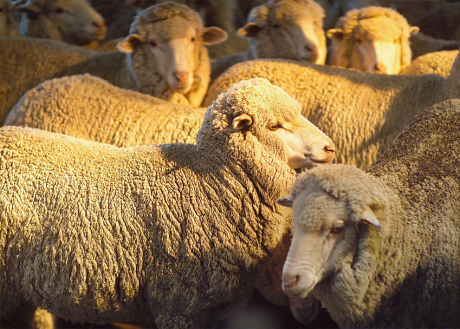Why Study Sheep Husbandry?
If you are thinking about running sheep or already have an established flock or work commercially with sheep then its important that you have the skills and knowledge to do so properly. This online sheep husbandry course will teach you everything you need to learn about sheep, such as the different breeds, how to select a suitable sheep for breeding, how to properly manage their health, how to handle wool, and more.
Improve your sheep management skills
Sheep have historically been one of Australia’s most important agricultural resources. In this course you will learn how to management aspects of sheep husbandry such as health and disease management, sheep nutrition and feeding, breeding, wool, lamb care, marketing and much more.
- tutored by practising Australian vets
- 100 hours self paced study
- affordable price
- suitable for anyone involved with sheep care.
Course Aims
- Select appropriate breeds of sheep for different purposes.
- Select sheep to be used for different production purposes.
- Explain the techniques used in sheep commercial breeding.
- Explain the procedures used in managing the health of sheep (Nutrition)
- Explain the procedures used in managing the health of sheep (Diseases)
- Explain the techniques used in the management of a commercial flock of sheep.
- To describe practices related to caring for lambs.
- Explain the processes involved in handling wool after shearing.
- Explain the techniques used in managing the marketing of sheep and sheep products.
Course Outline
There are 8 lessons in this course:
- Introduction; Terminology and Breeds
- Factors affecting the choice of breed
- Product and Market
- Rearing and Management System
- Overview of Sheep Breeds
- Sheep Terminology
- Selection and Breeding
- Growth Rate
- Reproductive Efficiency
- Carcass quality
- Wool traits
- Culling old ewes
- Selecting replacement ewes
- Selecting replacement rams
- Commercial Sheep Production
- Choosing a lambing time
- Autumn lambing
- Spring lambing
- Accelerated lambing
- Managing ewes prior to mating
- Using hormones to control reproduction
- Joining methods
- Anatomy of ewe reproductive organs
- Anatomy of ram reproductive organs
- Ultrasound
- Signs of lambing
- Nutrition of Sheep
- Anatomy
- Condition scoring
- When to condition score
- Factors affecting feed requirements
- Feeding rams
- Feeding ewes
- Feeding lambs and fatteners
- Nutrition and wool production
- Diseases of Sheep
- Viral and rickettsial diseases
- Bacterial diseases
- Metabolic diseases
- Protozoal diseases
- Poisoning
- Vaccination
- The medicine chest
- Giving injections
- Disease prevention through sound management
- General Management of a Commercial Flock
- Handling and treatment facilities
- Drenching
- Injecting
- Hoof Trimming
- Shearing
- Tail docking
- Castration
- Blowfly strike
- Care of the Lamb
- Abnormal Presentation
- Presentation: One front leg back
- Presentation: Both front legs back
- Presentation: Hind legs first
- Presentation: Head back, both front feet forward
- Presentation: Breech or tail first
- Presentation: Twin lambs presented together
- Post lambing care
- Drenching
- Rearing orphan lambs
- Lambing records
- Managing the fattening lamb
- Feeding
- Lamb marking
- Wool
- Characteristics of wool
- Types of wool
- Wool classing
- Wool processing
- Factors influencing the estimation of yield
- Piece Picking
- Wool Scouring
- Carding
- The Marketing of Sheep and Sheep Products
- Wool sales
- Sale by private treaty
- The auction system
- Wool futures
- Industry regulatory and marketing authorities
- Lamb and mutton marketing: Paddock sale, Saleyard auction, Over-the-hook sale
- Electronic Marketing, Live Sheep exports, Forward price contracts
- Factors affecting the value of lamb or mutton: Carcass weight, Skin value, Payment basis (hot or cold weight) etc
Activities in this course:
- Collect information about different sheep breeds which are being farmed or could be successfully farmed in your region.
- Compare the different characteristics of sheep breeds in terms of appearance, hardiness, commercial potential.
- Select breeds for three different purposes, including wool production and meat production, in your locality.
- Inspect at least two sheep, ideally, from separate flocks, and determine their age by looking in their mouths.
- Define the following different sheep breeding terms: Oestrus, Gestation, Weaning, Flushing, Wet ewes, Teasers.
- Design a “breeding record form” which includes all necessary factors.
- List criteria to be used for selecting sheep for different purposes, including for replacement and for slaughter.
- Develop a standard form, which considers both meat and wool, to use for judging sheep.
- Talk to at least two experienced sheep farmers about “condition scoring” of sheep.
- Compare the differences in food required by different types of sheep, including: rams; breeding ewes at different stages of pregnancy; sheep being fattened for meat.
- Prepare a collection of ten pasture plant species from at least two different sheep properties and comment on the suitability of the pasture for sheep.
- Distinguish between the different categories of sheep health problems, including: viral, bacterial, metabolic, protozoal, poisoning, parasites.
- Describe how to perform different pest and disease control tasks, including: drenching, injecting, hoof trimming, docking.
Enrol Now
- Experienced Tutor support
- Certificate sent to you
- Online study (Printed notes available)
- Self paced - no set timetable
- 12 months to complete course
From: $35.00 / week for 19 weeks
Get a Free Info Pack!











